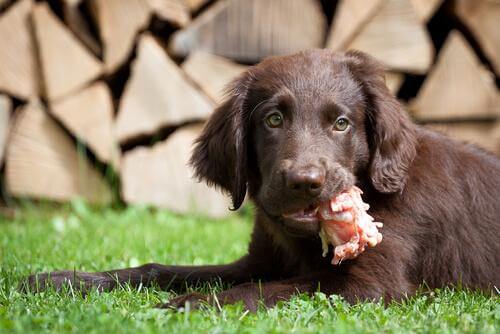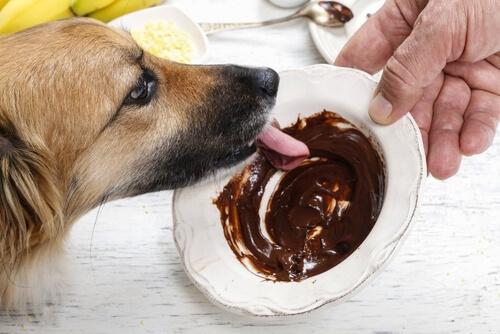How Do Dogs Digest Food?

If you’ve ever seen a dog throw up, you’ve probably realized that dogs don’t digest their food the same way we do. So, how do dogs digest food? And, what are the foods that are most difficult for them to digest?
Interestingly, both their mouths and their digestive systems are different than ours. We’re going to look into these aspects in a little more detail so that we can see how dogs digest food.
Animals’ mouths, where it all begins
Dogs’ mouths are very different from our own. For example, they have 42 teeth (10 more than people) and 2000 taste buds (7000 less than us). Despite having more teeth to chew with, they actually don’t do much. And, their lack of taste buds prevents them from thoroughly enjoying their meals.

However, this isn’t really important for dogs. That’s because, in the animal world, survival is the most important thing. This means being able to find food before other animals do, and then eating it as quickly as possible so that no one can take it from them.
That’s why they have more teeth. These enable them to break a bone down into small pieces so they can eat it more easily. However, they don’t stop to chew it, and this hinders total digestion.
In short, their goal isn’t to chew the food and wear it down, but to break it down into pieces so that it will get to their stomach as quickly as possible.
How dogs digest food
Another difference between us and dogs is our stomachs. When humans eat, we spend time chewing our food, allowing our saliva to mix it. Our saliva contains an enzyme that helps to break the food down.
In this way, it’s almost completely broken down by the time it reaches the stomach. Therefore, most of the work is already done.
However, as we already said, dogs don’t chew their food. This means that most of the hard work takes place in their stomach. The stomach and pancreas will generate the enzymes it needs to break down the food.
But, since dogs eat pretty much anything, the acids in its stomach are much stronger than ours, and break it down more easily.
So, while our digestive process takes between one and two hours, a dog’s will take about 8 hours. That’s why, if you’ve ever seen your dog throw up, he may have vomited half a burger.
Final digestion process
After that, the decomposed remains pass to the small intestine and could stay there for up to two days, depending on how difficult they are to decompose.
However, as we said earlier, the acids in a dog’s body are very strong, and they can eat practically anything. If we tried to eat those same things, we’d probably catch a bacterial disease.
But that’s not the case with dogs since their digestive system works so hard. Therefore, they can eat almost anything and not get sick. Sometimes, they even eat their own vomit! So, the final digestive process, until the animal excretes it, can take from 10 hours to 2 days.
Forbidden food
However, there are many foods that your animal shouldn’t eat, regardless of how strong his digestive system is. We’ve already covered this topic a few times, but we think it’s a good time to revisit it.

- Chicken bones. These are made up of small parts that become very sharp when the dog breaks them into pieces. They’re so sharp, they could actually kill your dog, even when they’re being broken down. Always keep them away from your dog.
- Onion. This vegetable contains components that attack the animal’s red blood cells and can cause anemia.
- Chocolate. Chocolate is one of the most dangerous foods for our pet. This isn’t just because of its high sugar content, which isn’t good for dogs. It also has to do with a component in chocolate that could poison, or even kill, your dog. Keep an eye on your furry friend so that he doesn’t accidentally get hold of this food.
- Beware of mixing food. You might think that your animal is getting tired of his regular dog food. However, mixing his dog food with raw foods can be dangerous if you don’t do it correctly. Remember, dogs digest these two foods differently, and at different times. If you do mix them, it should always be 90% feed to 10% raw food.
If you’ve ever seen a dog throw up, you’ve probably realized that dogs don’t digest their food the same way we do. So, how do dogs digest food? And, what are the foods that are most difficult for them to digest?
Interestingly, both their mouths and their digestive systems are different than ours. We’re going to look into these aspects in a little more detail so that we can see how dogs digest food.
Animals’ mouths, where it all begins
Dogs’ mouths are very different from our own. For example, they have 42 teeth (10 more than people) and 2000 taste buds (7000 less than us). Despite having more teeth to chew with, they actually don’t do much. And, their lack of taste buds prevents them from thoroughly enjoying their meals.

However, this isn’t really important for dogs. That’s because, in the animal world, survival is the most important thing. This means being able to find food before other animals do, and then eating it as quickly as possible so that no one can take it from them.
That’s why they have more teeth. These enable them to break a bone down into small pieces so they can eat it more easily. However, they don’t stop to chew it, and this hinders total digestion.
In short, their goal isn’t to chew the food and wear it down, but to break it down into pieces so that it will get to their stomach as quickly as possible.
How dogs digest food
Another difference between us and dogs is our stomachs. When humans eat, we spend time chewing our food, allowing our saliva to mix it. Our saliva contains an enzyme that helps to break the food down.
In this way, it’s almost completely broken down by the time it reaches the stomach. Therefore, most of the work is already done.
However, as we already said, dogs don’t chew their food. This means that most of the hard work takes place in their stomach. The stomach and pancreas will generate the enzymes it needs to break down the food.
But, since dogs eat pretty much anything, the acids in its stomach are much stronger than ours, and break it down more easily.
So, while our digestive process takes between one and two hours, a dog’s will take about 8 hours. That’s why, if you’ve ever seen your dog throw up, he may have vomited half a burger.
Final digestion process
After that, the decomposed remains pass to the small intestine and could stay there for up to two days, depending on how difficult they are to decompose.
However, as we said earlier, the acids in a dog’s body are very strong, and they can eat practically anything. If we tried to eat those same things, we’d probably catch a bacterial disease.
But that’s not the case with dogs since their digestive system works so hard. Therefore, they can eat almost anything and not get sick. Sometimes, they even eat their own vomit! So, the final digestive process, until the animal excretes it, can take from 10 hours to 2 days.
Forbidden food
However, there are many foods that your animal shouldn’t eat, regardless of how strong his digestive system is. We’ve already covered this topic a few times, but we think it’s a good time to revisit it.

- Chicken bones. These are made up of small parts that become very sharp when the dog breaks them into pieces. They’re so sharp, they could actually kill your dog, even when they’re being broken down. Always keep them away from your dog.
- Onion. This vegetable contains components that attack the animal’s red blood cells and can cause anemia.
- Chocolate. Chocolate is one of the most dangerous foods for our pet. This isn’t just because of its high sugar content, which isn’t good for dogs. It also has to do with a component in chocolate that could poison, or even kill, your dog. Keep an eye on your furry friend so that he doesn’t accidentally get hold of this food.
- Beware of mixing food. You might think that your animal is getting tired of his regular dog food. However, mixing his dog food with raw foods can be dangerous if you don’t do it correctly. Remember, dogs digest these two foods differently, and at different times. If you do mix them, it should always be 90% feed to 10% raw food.
This text is provided for informational purposes only and does not replace consultation with a professional. If in doubt, consult your specialist.








